How to unscrew the valve on a gas cylinder: safe ways to disconnect the valve
From an old cylinder you can build various useful devices, from a barbecue to a homemade stove.But first you need to disassemble it, and this will require skill. The first step is to deal with the valve.
Don’t know how to unscrew a gas cylinder, but are determined to do it yourself? We will help you deal with this issue. Our article discusses the main stages of unscrewing a valve and provides useful recommendations that will help you cope with this task. Step-by-step photos and thematic video materials have also been selected.
The content of the article:
Types and design of valve
Before moving on to practice, you need to get acquainted with the theory a little and figure out in which direction the valve on a household gas cylinder should be unscrewed. And also briefly consider the design of the cylinder and the valve itself. This knowledge will help you complete the task faster.
So, the main structural elements can be examined in detail in the following image.

Gas cylinder valve is a shut-off valve that is used for storage, use, filling and safe transportation of vessels (cylinders) operating under pressure.Features of their use are regulated Resolution No. 91 on safe operation dated June 11, 2003, which states that each product must comply with GOST and be marked with operating pressure and temperature.
Most often, valves of the VB-2 and VB-1 brands can be found on propane-butane cylinders. The body of such a crane is extremely simple and is equipped with a handwheel that can be easily rotated by hand. Such valves are installed on gas cylinders for pressures up to 1.6 MPa. It is possible to join them balloon reducer and a pressure regulator, for which the valve design has a union nut with a left-hand thread.
Connecting dimensions of valve brand VB-2:
- at the outlet for gas selection SP 21.8 - 14 threads per 1″ left;
- for installation on a cylinder - conical thread with diameter W19.2, W27.8, W30.3.
The side fitting of the valve of a cylinder used for storing flammable gases is always made with a left-hand thread. But for non-flammable ones - on the right. This measure is intended to protect the average user who decides to independently connect the cylinder to gas-using equipment.
This prevents accidental explosive mixing of, for example, propane-butane or hydrogen with oxygen.
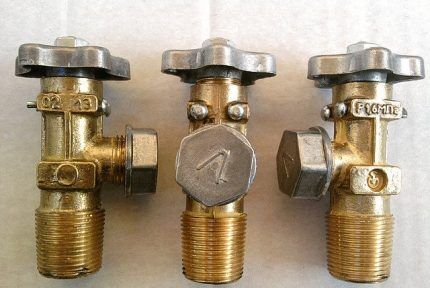
Detailed instructions for unscrewing the tap
Are you looking for information on how to quickly and safely turn off the tap on a propane-butane gas cylinder? Then read our instructions and see the step-by-step photos posted just below.
In order to cope without any difficulties with the valve, which can “sit tightly” in the neck of the cylinder, you will need to apply force.And, depending on the equipment at hand, you may need an assistant.
If you have only one cylinder, and you are going to twist the valve for the first time, you will have to tinker with it until you get the hang of it. If you are going disassemble the cylinder and put the production of various homemade products from cylinders on stream, then you simply cannot do without good tools at hand.
First you need to release the remaining gas, if any, in this cylinder. To do this, it is enough to turn the valve flywheel in the direction indicated on it. If there is still gas left inside, you will hear a characteristic hissing sound - this is the remaining liquefied gas coming out.

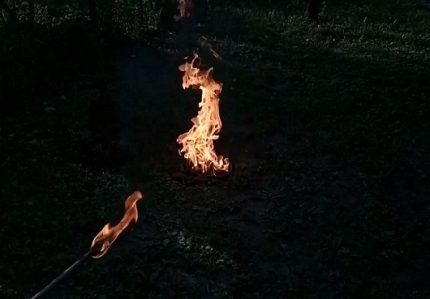
Then you need to secure the cylinder body. How to do this depends entirely on your imagination and the devices at hand. For these purposes, they use welding, metal pins, a vice, a board, clamp the cylinder with the wheel of a large car, fasten it to a tree with a belt, and many other options. Therefore, choose for yourself the method of fixation that will be convenient for you.
The main task is to immobilize the balloon. We will look at the process of unwinding a valve using the simplest example - using a vice. Step-by-step instructions can be found in the following photo collection.
In most cases, there are no problems with unscrewing the valve - this simple method allows you to easily unscrew it.
Review of the best ways to unscrew the valve
But the considered method is not the only one. Many home craftsmen offer a number of other options, using various available tools. We offer 7 simple ways to unscrew the valve using available tools. If you don't succeed the first time, you can always try another option.
Method #1 - clamping the shoe in a vice
You need to clamp the cylinder body in a vice. Why is the shoe securely fixed with a vice?
You will also need an adjustable wrench and a pipe to extend the handle.

Having put on mittens, all that remains is to grab the extended handle of the key and, with some effort, turn it counterclockwise. At first everything will go tight, but after making half a turn, the valve will move much easier. Finally, you can unscrew it by hand.
It's good for you! Rating of the best bench and machine vices: characteristics, pros, cons, price.
Method #2 - clamping the tap in a vice
The second method is no less simple than the previous one. All you need is to hold the cylinder valve in a vice and twist it by the body using belts.
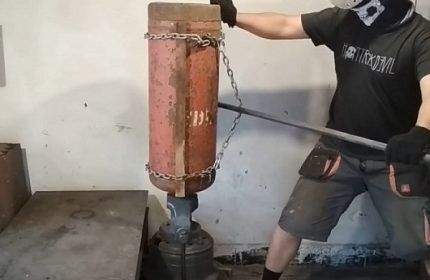
The first turn will be difficult, but then you can complete the unscrewing manually by putting the metal pipe aside.
Method #3 - vice + metal corner
This option provides for the same type of fastening of the cylinder in a vice as the previous one - with a tap in a vice. But instead of belts and chains, you will need a metal corner. It is welded to the shoe in two places.
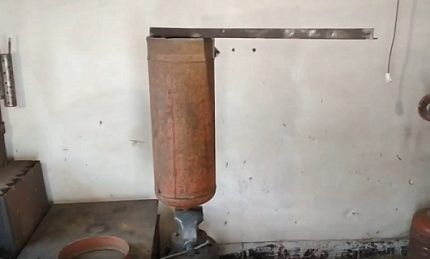
This welding method is simple if you have a welding machine in your garage and know how to use welding. As for safety, there is no need to be afraid to weld a metal structure to the shoe - this way you will not damage the cylinder in any way.
Method #4 - using two keys
To implement this method of unscrewing the valve, you will need two keys - No. 5 and No. 3.
Use a large wrench (No. 5) to tighten the thread onto which the shipping cap is usually screwed to protect the valve.
And key No. 3 will be used to unscrew the tap. It is advisable to lengthen its handle using a suitable piece of pipe.

Method #5 - welding the shoe
If you have a welding machine and know how to handle it, a convenient method will be to weld the base of the cylinder (shoe) to any surface. For example, to metal table legs or to a workbench. Moreover, it is enough to fix the stand by welding in two places.
Then you can use the same wrench #3 with a lever (a long metal pipe that fits over the handles of this wrench).

Method #6 - belts + key
Using belts or chains, you have to pull the body of the cylinder to something firmly fixed - a corner, a tree trunk. Then take key No. 3 and unscrew the tap, remembering that it has a conical right-hand thread - i.e. You need to turn it counterclockwise.
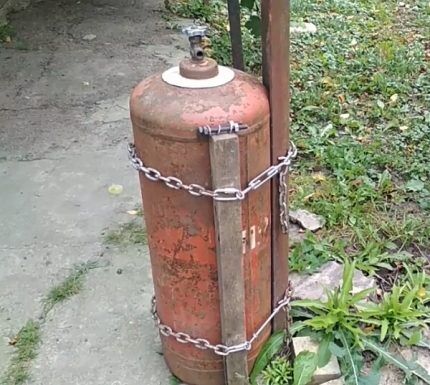
Method #7 - fixing the cylinder in the hole
Another reliable method of fixation is in a hole. First, you will need to screw a metal tube up to 1 m long to the shoe. For this, you can use the existing holes in the shoe. If they are not there, then drill them.
Then dig a hole approximately half the height of the vessel, place the prepared cylinder with a screwed-on tube inside, cover it with earth and compact it lightly.
All that remains is to take the key and unscrew the valve counterclockwise.
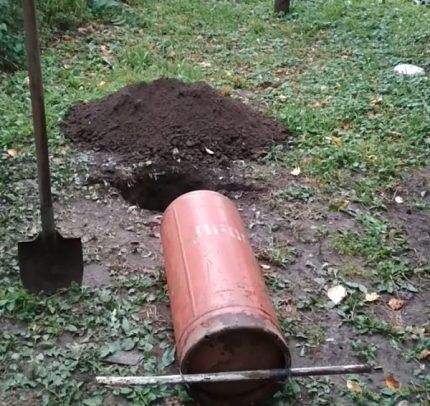
In winter, instead of a hole, you can use an ice hole by freezing a balloon in it.
Having figured out how you can unwind a gas cylinder at home, you can safely use any of the methods you like. But at the same time, it is important not to forget about safety - working with a cylinder can result in very disastrous consequences. Read more about this.
Safety rules when working with valves
If you have never worked on unscrewing a tap, then it would be a good idea to familiarize yourself with the safety rules before starting such work.
The operation of the valve is regulated by such documents as PB 12-368-00 “Safety rules in the gas industry”, Resolution No. 91 of June 11, 2003 “Rules for the design and safe operation of pressure vessels” and GOST 12.2.008-75.
Disassembly, repair and replacement of the valve should only be carried out by persons authorized to repair gas equipment. Repairing a device under pressure is strictly prohibited. Therefore, if you notice that the valve is leaking or faulty, then the right decision would be to contact a gas service representative, rather than carry out repairs at your own peril and risk.
If you want to disassemble an old cylinder in order to make a useful homemade product out of it like potbelly stoves, smokehouse or gas grill, then it is worth remembering that these actions cannot be called safe. And you will have to bear the consequences.
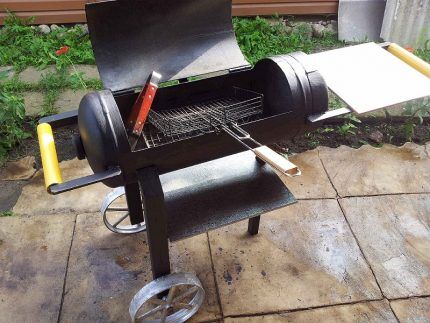
All actions to unwind the cylinder should be carried out outdoors or in a well-ventilated garage or other room. But this is strictly forbidden to do in an apartment - such an experience may end explosion.
Next, let's look at the basic safety rules that are important to follow:
- To release the remaining gas, you should smoothly and slowly unscrew the valve flywheel.
- Do not disassemble or cut a pressure cylinder under any circumstances.
- There should be no other cylinders near the vessel being disassembled.
If you are just about to unscrew the valve and have not had time to do anything yet, and the smell of gas is clearly audible in the garage where the cylinder was located, you should ensure that this room is ventilated as much as possible. Why open the gates, windows, doors (if any), and immediately leave.
Conclusions and useful video on the topic
If you have never unscrewed a valve from the neck of a cylinder, we recommend watching the following video:
Unscrewing the valve using a vice, metal pipe and clamp:
After familiarizing yourself with simple methods for unscrewing the gas cylinder tap, you can choose the most suitable one for yourself. But it is important to remember the safety rules - unfortunately, it is not uncommon for gas cylinders to explode due to careless handling by ordinary people. Therefore, after weighing all the pros and cons, it is better to go to a gas station, where for a nominal fee they will unscrew the tap from the old cylinder or replace it.
Do you have your own opinion about unwinding a gas cylinder in makeshift conditions using improvised means and would you like to share it with other users? Or would you like to tell us about your experience of unscrewing the valve? Write your comments, add original photos, participate in the discussion - the feedback form is located below.



